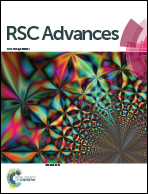Dithieno[3,2-a:2′,3′-c]phenazine-based chemical probe for anions: a spectroscopic study of binding†
Abstract
The synthesis of a new anion-responsive molecule N,N′-(2,5-bis(4-(tert-butyl)phenyl)dithieno[3,2-a:2′,3′-c]phenazine-9,10-diyl)bis(4-methylbenzenesulfonamide) (1) is reported. The sensitivities of the spectroscopic properties of 1 in the presence of various anions were examined using UV-vis absorption spectroscopy, fluorescence and 1H NMR titration experiments. Strong binding of 1 to carboxylate, cyanide, fluoride and dihydrogen phosphate anions results in an increase in quantum yield for emission of 1, and changes in its 1H NMR chemical shifts. A significant electrostatic interaction of the tetrabutylammonium cation with 1, upon strong binding with the counter anion, was also indicated by the chemical shifts observed in the 1H NMR titrations. Binding constants of 1 to anions are also calculated based on the binding isotherms derived from NMR and UV-vis titrations. DFT calculations show that the anion does not significantly impact the HOMO/LUMO levels (and subsequently the S0 → S1 transition), but rather changes the strength of the S0 → S2 transition, which accounts for the observed changes in the UV-vis spectra.
![Graphical abstract: Dithieno[3,2-a:2′,3′-c]phenazine-based chemical probe for anions: a spectroscopic study of binding](/en/Image/Get?imageInfo.ImageType=GA&imageInfo.ImageIdentifier.ManuscriptID=C5RA01416F&imageInfo.ImageIdentifier.Year=2015)

 Please wait while we load your content...
Please wait while we load your content...